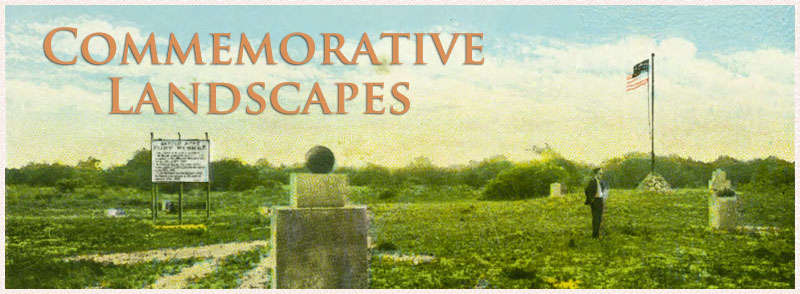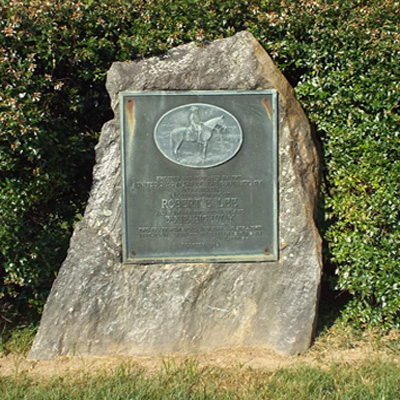
Robert E. Lee Dixie Highway Marker, Fletcher
The memorial was comprised of a rectangular bronze plaque attached to a large granite boulder. In relief inside an oval that encompassed one third of the plaque was a representation of General Robert E. Lee astride his horse Traveler. The inscription, also in relief, appeared below the oval. The Robert E. Lee Dixie Highway marker was placed at Calvary Episcopal Church which had served as a Confederate Hospital during the war. This memorial and 18 others that formed the “Open Air Westminster of the South” were removed in October 2020. (See "Controversies" below)
Images:
Far-off view with the plaque |
Boulder with the removed bronze plaque
ERECTED AND DEDICATED BY THE / UNITED DAUGHTERS OF THE CONFEDERACY / AND FRIENDS / IN LOVING MEMORY OF / ROBERT E. LEE / AND TO MARK THE ROUTE OF / THE DIXIE HIGHWAY / “THE SHAFT MEMORIAL AND HIGHWAY STRAIGHT / ATTEST HIS WORTH - HE COMETH TO HIS OWN” / - LITTLEFIELD - / ERECTED 1926
Moses Wood Camp, United Daughters of the Confederacy
May 2, 1926
35.443040 , -82.505790
View in Geobrowse
Confederate Veteran, 34, (1926), p.161 Link
Butler, Douglas J. Civil War Monuments, An Illustrated History (Jefferson, NC: McFarland & Company, Inc., 2013), 193
“Calvary Church, Fletcher, N.C. Between Asheville and Hendersonville,” in Durwood Barbour Collection of North Carolina Postcards (PO77), North Carolina Collection Photographic Archives, The Wilson Library, University of North Carolina at Chapel Hill Link
“Daughters Will Donate Markers for State Roads,” The Robesonian (Lumberton, NC), October 26, 1925
“Dixie Highway Plaque-Fletcher, NC,” Waymarking.com, (accessed June 6, 2016) Link
“Robert E. Lee Dixie Highway,” The Historical Marker Database, HMdb.org, (accessed June 6, 2016) Link
Yes
Bronze, granite
United Daughters of the Confederacy, North Carolina Division. Funding: Committee comprising members of Calvary Episcopal Church
The Fletcher and Asheville markers were both dedicated on Sunday, May 2. The Asheville dedication was first after which Mrs. James Madison Gudger, Jr., chair of the Dixie Highway Committee for the U.D.C. in North Carolina and others travelled to Fletcher for the second dedication. The Fletcher activities began with the Sunday sermon by the Reverend Clarence McClellan on Robert E. Lee. The unveiling was performed by Mrs. Gudger (who also unveiled the Asheville marker). For this ceremony the governors of both Virginia and North Carolina were present. An address on Robert E. Lee was given by Lucian Lamar Knight, state historian of Georgia at both dedications.
The Dixie Highway was first planned in 1914 and became part of the National Auto Trail system and initially was intended to connect the Midwest with the South. Rather than a single highway the result was more a small network of interconnected paved roads. It was constructed and expanded from 1915 to 1927. The eastern route of the Dixie Highway mostly became U.S. Highway 25. Starting in the late 1920s, the United Daughters of the Confederacy placed bronze plaques on granite pillars to mark the route of the Dixie Highway and honor General Robert E. Lee. Now mostly removed or stolen examples in North Carolina could be found in Marshall and Hot Springs in Madison County, in Asheville in Buncombe County and in Fletcher, Hendersonville and near Tuxedo all in Henderson County.
The efforts to mark the Dixie Highway in North Carolina were led by Mrs. James Madison Gudger, Jr. of Asheville who also designed the plaque. The North Carolina Division of the United Daughters of the Confederacy raised $800 to have the die cast for the plaque and then loan it to other states for marking their highways. Other states do not appear to have taken advantage of the die aside from an example in Greenville, South Carolina. It is thought that 10 total were made from this die leaving several unaccounted for. This marker was placed at Calvary Episcopal Church because it had served as a Confederate hospital during the war.
Following the massacre of nine African Americans in a church in Charleston, South Carolina on June 17, 2015 by white supremacist Dylann Roof, Americans, especially southerners, have reflected on and argued over the historical legacy of slavery, the Civil War, the Confederacy, and white supremacy. Monuments have been a particular focus of these debates and controversies, especially after the death of a counter-protester, Heather Heyer, at a white supremacist rally in Charlottesville, Virginia in August 2017 and after President Donald Trump expressed his opposition to the removal of Confederate memorials. Despite laws in many southern states intended to prevent or impede the removal or relocation of historical monuments, protesters and local community leaders have removed or relocated controversial monuments associated with slavery, the Confederacy, and white supremacy. The pace of the removal of controversial monuments accelerated sharply in 2020, following the death of George Floyd at the hands of police in Minneapolis, Minnesota.
On church grounds also stood a unique collection of such monuments associated with the Dixie Highway marker. They had been envisioned as an “Outdoor Westminster Abbey of the South” by Dr. Clarence Stuart McClellan, Jr., pastor of the church from 1924 to 1930, His ides of the “Abbey” was to "memorialize the fine and noble things in the Old South and pass these on through bronze and granite to future generations." He conceived the idea of having various patriotic and civic organizations erect native stone monuments with appropriate bronze tablets on them. He had expressed his hope that the monuments would serve as a means for reconciling the combatants of the Civil War and this explains why many of the memorials were to men from both southern and northern states. Beginning in Lent of 2020, Calvary Episcopal began conversations with journalists, historians, and clergy to help understand the role, if any, a 1920s vision of reconciliation had with the churches understanding of God’s call to reconciliation for all people in the 2020s. Following these conversations a decision was made to remove the memorials which occurred in October 2021. In August of 2022, the stones minus the memorial plaques were arranged around the perimeter of an existing labyrinth at Calvary. Creative works of art are planned for the spaces on the stones that once held the plaques. This art “will be intended to help visitors to the labyrinth enter into a contemplative reflection on Christ’s mission of healing and reconciliation.” The stones being repurposed in this manner are intended to further transform the labyrinth experience and with the addition of explanatory signage give emphasis to the healing of traumatic experiences, especially the trauma of war.
The removed plaques which were donated by the United Daughters of the Confederacy including the “Dixie Highway” plaque that was not a part of the “Abbey” were returned to the Moses Wood camp of the United Daughters of the Confederacy. A successor organization to the B’nai B’rith Lodge of Asheville agreed to receive the Zebulon Vance plaque, and efforts were made to return other plaques to the parties which contributed them.
Calvary Episcopal Church is located at 2840 Hendersonville Road at its intersection with Old Airport Road in Fletcher, NC. The granite boulder without the bronze memorial plaque is located a few feet off Hendersonville Road in front of a hedge to the left of the churches front driveway.
As of early 2023, the granite boulder without the bronze plaque still stands on the grass, with tall evergreen bushes serving as a backdrop.
Calvary Episcopal Church is located at 2840 Hendersonville Road at its intersection with Old
Airport Road in Fletcher, NC. The marker was located a few feet off Hendersonville Road in front of a hedge to
the left of the churches front driveway.
Eighteen “Open Air Westminster of the South” markers stood in two rows in a lawn area facing
Old Airport Road to the right of the church. A memorial to Bill Nye stands in the middle of the
front lawn with a second memorial to Nye in the church cemetery. The Calvary Episcopal
Church marker stands near the front entrance to the sanctuary.
 Know anything else about this monument that isn't mentioned here? If you have additional information on
this or any other monument in our collection fill out the form at the Contact Us link in the footer. Thank you.
Know anything else about this monument that isn't mentioned here? If you have additional information on
this or any other monument in our collection fill out the form at the Contact Us link in the footer. Thank you.

